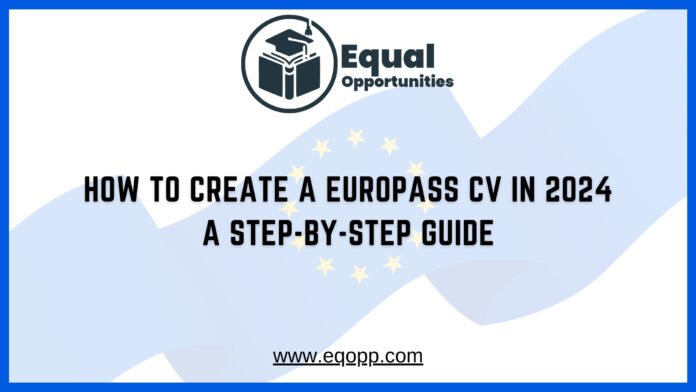Creating a standout CV is essential for scholarship and job seekers in today’s competitive market. With this “How to Create a Europass CV” step by step guide you can create a CV that is recognized across Europe and offers a standardized way to present your qualifications, making it easier to apply for jobs across different countries. In this guide, we’ll walk you through the process of creating a Europass CV, ensuring that it’s optimized for search engines and adheres to the latest guidelines.
A Europass CV is an excellent tool for job seekers, students, and professionals looking to apply for opportunities across Europe. Recognized for its standardized format, the Europass CV helps present your skills and qualifications in a clear, organized way. Here’s a step-by-step guide to creating your Europass CV.
What is a Europass CV?
The Europass CV is a structured template designed to help students, graduates, and professionals showcase their skills, experiences, and qualifications in a consistent and professional manner. It’s widely recognized across Europe, making it an ideal choice for those seeking various opportunities such as scholarships, jobs, fellowships, training programs, internships, and research positions within the EU.
Quick Overview of the Europass CV Process
- Official Website: Europass
- Create Your CV: Europass CV Editor
- Profile Setup: Profile Wizard
- Languages Supported: 31 languages
- CV Benefits: Standardized, professional format recognized across Europe
1. Start with the Europass CV Builder
The Europass CV Builder is an online tool designed to make creating your CV easy and accessible.
- Access the Builder: Go to the Europass CV Builder.
- Create a Europass Profile: Set up your profile, which will act as a record of your education, work experience, skills, and other qualifications.
- Language Selection: The Europass website supports multiple languages, so you can create your CV in your preferred language.
Tip: Once your profile is complete, you can generate multiple CVs tailored to different job applications.
2. Complete Your Personal Information
Accurate personal information forms the foundation of your Europass CV.
- Full Name, Address, Phone, and Email: Make sure all contact information is current.
- Professional Photo: Add a professional-looking photo if appropriate for the job or country you’re applying to.
3. Add Your Work Experience
The Work Experience section allows you to present your professional background clearly and concisely.
- Reverse Chronological Order: List your most recent job first.
- Job Title and Employer: Include your title and the name of the organization.
- Key Responsibilities: Use bullet points to list the main duties and achievements for each role.
- Employment Dates: Mention the start and end dates for each position.
4. Highlight Your Education
Showcase your academic background, starting with your latest qualifications.
- Degree and Institution: Mention the qualification (e.g., Bachelor’s Degree) and the institution’s name.
- Dates of Study: Include the start and end dates for each qualification.
- Relevant Courses: List specific courses or projects that are relevant to the job you’re applying for.
5. Showcase Your Skills
The Skills section is where you can highlight your unique talents and proficiencies.
- Language Skills: Indicate the languages you speak and your proficiency level.
- Digital Skills: Mention any relevant technical skills, such as software or programming languages.
- Other Skills: Include soft skills like teamwork, communication, and leadership.
6. Choose a Template and Customize Your CV
Europass provides various templates, so you can select one that aligns with the industry or position you’re targeting.
- Template Selection: Choose a layout that reflects professionalism and suits your style.
- Customization: Adjust your CV to highlight experiences and skills relevant to the job.
Tip: Always tailor your CV for each position by emphasizing skills and experiences that match the job description.
7. Download, Save, and Share Your Europass CV
Once you’ve finalized your Europass CV, you can download it or store it in your Europass Library for easy access.
- Download Options: Choose from formats like PDF and Word.
- Save in Europass Library: Store your CV in the Europass Library, allowing you to update or share it with employers quickly.
Tip: You can also share your CV directly with employers or job platforms like EURES through your Europass account.
8. Final Review
Before submitting your Europass CV, perform a thorough review to ensure it’s polished and professional.
- Proofread: Check for spelling and grammar errors.
- Formatting: Ensure your CV is visually clean, consistent, and easy to read.
- Regular Updates: Keep your CV updated with your latest experiences and qualifications.
Additional Tips for Creating an Effective Europass CV
- Clarity and Simplicity: Avoid jargon, and use clear language to make your CV easy to understand.
- Tailor for Relevance: Focus on the skills and experiences most relevant to the position you’re applying for.
- Consistent Formatting: Maintain uniform fonts, sizes, and spacing for a professional appearance.
- Personal Statement: Begin with a summary that highlights your key qualifications and career goals.
- Quantify Achievements: Use specific numbers where possible (e.g., “Increased sales by 20%”) to demonstrate your impact.
- Action Verbs: Use strong verbs like “managed,” “led,” “developed,” and “achieved” to bring your experiences to life.
- Proofread Carefully: Double-check for any typos or grammatical errors, as a polished CV reflects your attention to detail.
Why Choose a Europass CV?
- Standardized Format: The Europass CV format is consistent, making it easy for employers across Europe to review.
- User-Friendly Builder: The Europass online CV builder is accessible to users of all levels, making CV creation simple and efficient.
- Recognized in Europe: Europass CVs are widely accepted across Europe, ideal for job seekers, students, and professionals applying for opportunities in the EU.

